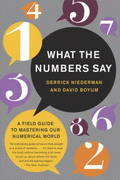NUMERACY
These books focus on numeracy taken generally. See other pages such as Authors/Paulos.
This page is not produced, reviewed or approved by the authors or publishers of these books.


What the Numbers Say: A Field Guide to Mastering Our Numeric World
by Derrick Niederman and David Boyum (1st ed. 2003).
DERRICK NIEDERMAN received a B.A. in mathematics from Yale and a Ph.D. in mathematics from MIT. He is the author of This Is Not Your Father’s Stockpicking Book, The Inner Game of Investing, and A Killing on Wall Street. DAVID BOYUM received a B.A. in applied mathematics and a Ph.D. in public policy from Harvard. He has been a visiting scholar at the Yale School of Management and a Robert Wood Johnson Scholar in Health Policy Research at Yale.
Table of Contents:
- The Quantitative Information Age
- The Ten Habits of Highly Effective Quantitative Thinkers
- For Good Measure
- Playing the Percentages
- Gaining Perspective
- Throwing a Curve
- Taking Chances
- The Proof is in the Numbers
- A Peace Offering for the Math Wars
Book Description (Front Cover):
Our society is churning out more numbers than ever before, whether in the form of spreadsheets, brokerage statements, survey results, or just the numbers on the sports pages. Unfortunately, people’s ability to understand and analyze numbers isn’t keeping pace with today’s whizzing data streams. And the benefits of living in the Information Age are available only to those who can process the information in front of them.
What the Numbers Say offers remedies to this national problem. Through a series of witty and engaging discussions, the authors introduce original quantitative concepts, skills, and habits that reduce even the most daunting numerical challenges to simple, bite-sized pieces. Why do the nutritional values on a Cheerios box appear different in Canada than in the U.S.? How is it that top-performing mutual funds often lose money for the majority of their shareholders? Why was the scoring system for Olympic figure skating doomed even without biased judges?
By anchoring their discussions in real-world scenarios, Derrick Niederman and David Boyum show that skilled quantitative thinking involves old-fashioned logic, not advanced mathematical tools. Useful in an endless number of situations, What the Numbers Say is the practical guide to navigating today’s data-rich world.
Comments (Back Cover):
“This is a superb book—important and fun to read. We live in an age in which all people need to be fluent in two languages–words and numbers. Yet our schools do not teach and our students do not learn how to be quantitatively literate. This book demonstrates what traditionally is not taught, but desperately needs to be—the application, uses, and abuses of numbers.” — Arthur Levine, President, Teachers College, Columbia University
“Entertaining, interesting, and educational. A real winner!” — Brian L. Roberts, President and CEO, Comcast Corporation
“This book is full of insights. With examples ranging from baseball to Social Security to the stock market, the authors make the numbers we live with everyday understandable and accessible. Read this book and you will probably double your numerical literacy. What’s more, you will enjoy the read!” — Joseph S. Nye Jr., Dean, John F. Kennedy School of Government, Harvard University
“It’s almost always about the numbers! What the Numbers Say is a witty and engaging book that highlights just how critical understanding the numbers is to our daily life.” — David Bach, best-selling author of Smart Couples Finish Rich and Smart Women Finish Rich
“Numbers have always been important in daily living, but now the computer and the Internet have made them more indispensable than ever. The authors of this splendid volume show us how to cope with the numbers that bombard us from all directions. Do you understand sports statistics? Can you spot the flimflams in statistical claims about health and medicine? If you don’t want to be a dummy about quantitative information, then read this book. It will tell you all you need to know, in clear and entertaining prose.” — Martin Gardner, author of The Colossal Book of Mathematics, and former “Mathematical Recreations” columnist, Scientific American
How to Lie With Charts (Paperback)
by Gerald Everett Jones. iUniverse (July 2000)
Book Description
The numbers don’t lie...or do they? Our society relies more on visual presentation of information than ever before. By exposing the tricks of the trade, How to Lie with Charts shows you how to create effective, truthful presentations and how to spot deceptive ones.
With easy-to-understand lessons and case studies that use popular software like Microsoft PowerPoint®, you’ll learn to present information more clearly and how to avoid the pitfalls associated with automatic chart-generation tools. Discover how chart format, data placement, and even your label and color choices can influence your audience. Throughout the book, special icons point out helpful hints as well as time-consuming liars’ tricks.
An engaging book, full of real-world examples, How to Lie with Charts shows you:
- When to use pie charts and which slice of the pie is most important
- How to lay out a chart that satisfies those starving number-crunchers
- Why “liars” prefer tables to charts and some other common “liar’s tips”
- The psychology of color and why blue means “reliable” to some people, but “cold” to others
- Why and where liars use the prettiest pictures
It’s not necessarily about lying—it’s about clear, persuasive communication. How to Lie with Charts teaches you to create a slide show worth watching and how to spot one worth watching out for.
Information Graphics: A Comprehensive Illustrated Reference (Paperback)
by Robert L. Harris
Numbers Guide: The Essentials of Business Numeracy Fifth Edition (The Economist Series) [ILLUSTRATED] (Hardcover)
by Richard Stutely
Turning Numbers into Knowledge: Mastering the Art of Problem Solving (Hardcover)
by Jonathan G. Koomey
Show Me the Numbers: Designing Tables and Graphs to Enlighten (Hardcover)
by Stephen Few
